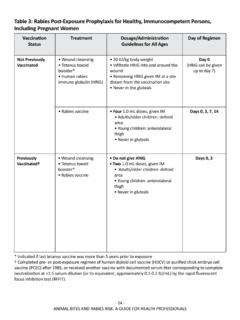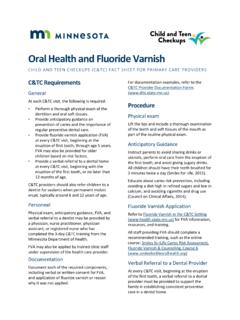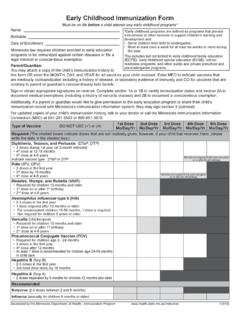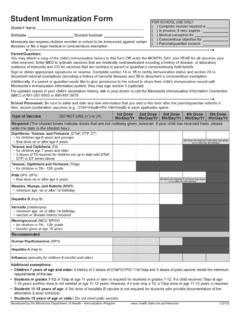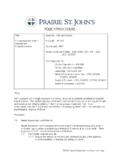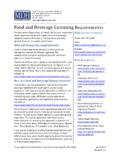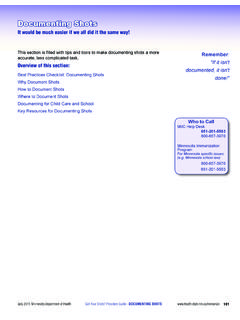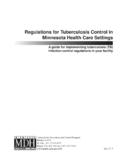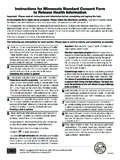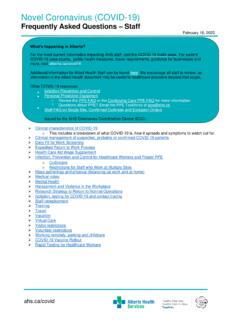Transcription of Responding to and Monitoring COVID-19 Exposures in Health ...
1 M I N N E S O T A D E P A R T M E N T O F H EA L T H 1 of 7 Responding to and Monitoring COVID-19 Exposures in Health Care Settings 12/8/2 0 2 1 CDC has updated their recommendations for Health care workers. Updated recommendations can be found at Interim Guidance for Managing Healthcare Personnel with SARS-CoV-2 Infection or exposure to SARS-CoV-2 ( ). MDH is working to update this guidance. exposure risk assessment and Monitoring Health care organizations should identify, manage, and monitor Health care workers (HCW) with workplace and community Exposures to people with confirmed COVID-19 disease.
2 This approach calls for timely identification of HCW who have contact with a coworker, patient, visitor ( , parent of pediatric patient), congregate care resident, or household or community member who has confirmed COVID-19 , beginning two days before onset of the infected person s symptoms. Potential Exposures should be identified and assessed in all Health care settings including hospitals, emergency departments, outpatient clinics, home Health services, long-term care facilities and assisted living facilities, or any facility where patient care is provided.
3 In Health care settings, potential exposure includes direct patient contact as well as brief interactions with coworkers or patients/residents with confirmed COVID-19 disease. Examples of brief interactions include brief conversations at the triage desk; briefly entering the patient or resident room, regardless of direct contact with the case or case s secretions/excretions; and entering the case room immediately after the case is discharged. When a potential exposure is identified, a structured risk assessment should be conducted, with individual employees receiving recommendations for Health Monitoring , voluntary quarantine, and social distancing, as relevant.
4 Details on how to monitor are explained below; exposure risk categories are found on the Center for Disease Control and Prevention website: Interim Guidance for Managing Healthcare Personnel with SARS-CoV-2 Infection or exposure to SARS-CoV-2 ( ). Identifying and excluding those who have had higher-risk Exposures should be conducted in parallel with other mitigation strategies, including employee Health screening, universal masking for source control, strict enforcement of excluding ill workers, and education covering infection prevention, appropriate personal protective equipment (PPE) use, and social distancing in the workplace and community.
5 Higher-risk Exposures R E S P O N D I N G T O A N D M O N I T O R I N G C O V I D-1 9 E X P O S U R E S I N H E A L T H C A R E S E T T I N G S 2 of 7 include an occupational interaction while not using all appropriate PPE according to CDC risk assessment criteria, or prolonged close contact with a social or household contact who has COVID-19 . Health care facilities should inform HCW who have been exposed to COVID-19 , promptly conduct a risk assessment, exclude unvaccinated HCW with higher-risk Exposures from patient care activities, and notify patients who have been exposed to HCW with COVID-19 , as appropriate.
6 Initial exposure risk assessment Assessment of initial exposure risk should occur as soon as possible after contact with a confirmed COVID-19 -positive person is recognized. When facility resources allow, the assessment should be conducted through an active process that includes an interview with the Health care worker . Details on the risk levels are found on CDC s website, Interim Guidance for Managing Healthcare Personnel with SARS-CoV-2 Infection or exposure to SARS-CoV-2 ( ). Passive reporting ( , use of log sheet) of personal protective equipment adherence and breaches by HCW should be used only if resources are not available to actively assess exposure risk.
7 The facility should inform HCW of their exposure and risk level. Ongoing Health care worker Monitoring for settings with confirmed COVID-19 inpatients or residents Daily or end-of-shift exposure risk assessments should be conducted for HCW having repeated/ongoing contact with an inpatient or resident diagnosed with confirmed COVID-19 . The first time a Health care worker has contact with a COVID-19 positive patient or resident, an initial exposure risk assessment should be conducted. The daily or end-of-shift exposure assessment should occur each day the Health care worker has contact with the positive patient or resident.
8 If facility resources allow, the exposure risk assessment should be conducted through an active process that includes a Health care worker interview. Protecting Health care workers during widespread community transmission Widespread community transmission puts all Health care workers at some risk for exposure to COVID-19 , whether in the workplace or in the community. When community transmission is more prevalent, it may become unmanageable for an individual Health care organization to conduct contact tracing and risk assessment of all Health care workers potentially exposed to a patient, resident, or coworker with confirmed COVID-19 .
9 If facilities have exhausted all options for targeted contact tracing, risk assessment, and exclusion, they should prioritize efforts to identify recognized Exposures ( , PPE breaches), institute Monitoring of Health care workers for fever and symptoms, and strictly deter Health care workers from working while ill ( presenteeism ).1 Facilities could consider this approach if they have sufficient personal protective equipment (PPE) to ensure that higher-risk Exposures are unlikely and have the ability to actively assess PPE breaches after every employee s shift.
10 All facilities should continue to exclude ill staff. 1 CDC: Interim Guidance for Managing Healthcare Personnel with SARS-CoV-2 Infection or exposure to SARS-CoV-2 ( ) R E S P O N D I N G T O A N D M O N I T O R I N G C O V I D-1 9 E X P O S U R E S I N H E A L T H C A R E S E T T I N G S 3 of 7 Management of exposed Health care workers Once the risk assessment has been completed and a risk level has been established for HCW who had contact with a person with confirmed COVID-19 , the facility should perform the following actions.
